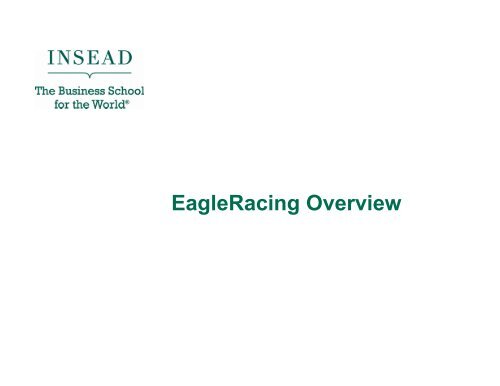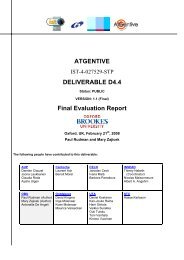EagleRacing Overview - INSEAD CALT
EagleRacing Overview - INSEAD CALT
EagleRacing Overview - INSEAD CALT
You also want an ePaper? Increase the reach of your titles
YUMPU automatically turns print PDFs into web optimized ePapers that Google loves.
<strong>EagleRacing</strong> <strong>Overview</strong>
<strong>EagleRacing</strong>: Objectives & Context<br />
Introduction Video:<br />
http://www.calt.insead.edu/eis/<strong>EagleRacing</strong>/<strong>EagleRacing</strong>Intro.wmv<br />
YouTube video about the origins of <strong>EagleRacing</strong> at<br />
Ferrari in Maranello, Italy:<br />
http://www.youtube.com/v/XOw_xYty8eM
Description of the “Story” (1)<br />
Role-playing Storyboard<br />
Collaboration<br />
Experiences<br />
addressed<br />
Learning<br />
Levels<br />
addressed<br />
Face-to-face<br />
Simple Email<br />
Exchange<br />
Advanced<br />
Collaboration<br />
Technologies<br />
Web 2.0<br />
Collaboration<br />
Environments<br />
Individuals<br />
Small Teams<br />
Large Groups<br />
Virtual<br />
Communities<br />
See the first Episode (use keyword “test”):<br />
EPISODE 1
Description of the “Story” (2)<br />
The videos trace the story of Gianluca Paranelli, a high-level decision maker of <strong>EagleRacing</strong>, a car racing<br />
company, as he faces several crucial dilemmas. For instance:<br />
•He must decide between two very different, mutually exclusive sponsors, desperately needed in<br />
order to guarantee his company’s future.<br />
•He must face a complex and critical management decision, such as deciding whether or not to pull<br />
out of a race at the last minute, given a possible risk of car engine failure, top management<br />
pressure, experts’ disagreements, and the fact that the potential sponsor is present and plans to<br />
sign the contract after the race.<br />
•He must decide whether to share problems openly with the prospective sponsor, or hide<br />
potentially damaging information.<br />
In addition to the videos, supplementary information is made available online for each dilemma<br />
including graphs, data and newspaper articles.<br />
See the first Email used to activate the Participants online:<br />
Starting Email
Example: <strong>EagleRacing</strong> @ Nissan. How does it<br />
contribute to the Integration<br />
<strong>Overview</strong> of Competencies and Contribution Areas<br />
addressed:<br />
There are 7 cells which are particularly addressed by the<br />
<strong>EagleRacing</strong> experience (Red X)<br />
•There are 2 Red X in the “Operational Decision Making”<br />
competency row<br />
•There are 2 Red X in the “Developing Strategic<br />
Relationships” Competency row.<br />
•There are 2 Red X in the “Shared Vision & Global<br />
Thinking” Contribution Area column<br />
•There is 1 Red X addressing particularly the “Business<br />
Acumen” row and the “Profit Consciousness” column<br />
Beyond these 7 Red X, there are also a number of Blue X.<br />
These are cells that are addressed by the <strong>EagleRacing</strong><br />
experience, but instead of being the subject of an extensive<br />
focus/debriefing, can be handled in less depth (e.g. without<br />
providing additional conceptual framework), but by asking<br />
the participants to use what they have learned in other<br />
courses and then stimulate self-reflection / self-assessment<br />
in the light of how successfully these competencies have<br />
been used by each manager during the <strong>EagleRacing</strong><br />
experience.
Additional Dimension<br />
The <strong>EagleRacing</strong> experience also involve the participants with<br />
online video viewing and email exchanges (in teams)<br />
before they even start the Program. This means that the first<br />
part of the experience starts online and on–the-job, and it is<br />
then completed and debriefed at the end of the Program as an<br />
Integrative Experience.<br />
The online component of <strong>EagleRacing</strong> is important to engage the<br />
participants in advance and help them address/experience<br />
their Business/ Management, Leadership, and Interpersonal<br />
Skills in both traditional and distributed collaboration<br />
settings/situations.
Vignette 1 & Related Conceptual Models<br />
After viewing the first Episode online (see previous slide & video), participants are asked to express their<br />
intuitive decision and send them individually to the professor (see Email link in previous slide).<br />
After this first step, Teams are created in order to maximize Diversity (Different Perspectives on the<br />
Dilemma, as well as cross-cultural differences) on the dilemma represented in the first Episode. The Teams<br />
now, rather than the individuals, need to reach a consensus, using exclusively email as a way of<br />
communicating.<br />
This virtual team experience, together with the teamwork following the other 3 dilemmas (and in particular<br />
Dilemma 2, which is modelled on the well-documented group decision which lead NASA to launch of the<br />
Challenger in 1986) , provides a very rich opportunity to experience effective vs ineffective team decision<br />
making processes on- and offline, addressing particularly the Competency “Operational Decision Making”<br />
in the two Areas “Innovation and Flexibility” and “Acc. & Decision Making”.<br />
A number of concepts and guidelines addressing Group Decision Making in Distributed and Diverse<br />
Management Teams can now be introduced and discussed, using the protocols of the teams exchanges to<br />
illustrate:<br />
•Decision Making Traps both on- and off-line,<br />
•The characteristics of successful/high-performance teams,<br />
•The need to acknowledge and address cultural differences,<br />
•The emergence of innovative ideas/solutions<br />
•The challenge of reaching consensus<br />
•The different processes supporting the team to be both efficient and effective<br />
Specific references to articles describing the conceptual models discussed, can be found in:<br />
http://www.calt.insead.edu/eis/<strong>EagleRacing</strong>/ERDebriefingSlides.mht
Vignette 2 & Related Conceptual Models<br />
During the different stages of the simulation, participants experience different types of collaboration<br />
technologies and media. This experience is followed up naturally with the introduction of concepts<br />
addressing important Trends related to New Forms of Collaboration:<br />
-Enhanced collaboration & Innovation among distributed groups (or internal communities) of managers<br />
through Web 2.0 environments concept of “Entreprise 2.0”<br />
-New forms of collaboration (“mass collaboration” reaching to customers and other players beyond the<br />
organizational boundaries) concept of “Wikinomics”<br />
This dimension of <strong>EagleRacing</strong> facilitates hence the introduction and discussion of concepts and trends<br />
addressing particularly the Competency “Developing Strategic Relationships” which are particularly<br />
relevant for the two Areas “Customer Focus”and “Innovation and Flexibility”.<br />
Specific references to articles describing the conceptual models discussed, can be found in:<br />
http://www.calt.insead.edu/eis/<strong>EagleRacing</strong>/ERDebriefingSlides.mht
Vignette 3 & Related Conceptual Models<br />
After the Racing-NotRacing Dilemma (Episode 2) we always experience a big diversity between the<br />
decisions of the different teams - some insist vehemently to race (even if the internal experts do not<br />
agree) whilst other teams decide that the best decision is not to race.<br />
This diversity of views enables to introduce a further Dilemma: Shall the teams proceed individually on<br />
their path, or shall they try to collaborate and reach a global consensus Typically teams prefer to<br />
proceed individually, rather than to collaborate towards a joint, and potentially better, decision.<br />
At this point the experience becomes the basis for a fundamental discussion of:<br />
-Benefits and drawbacks of collaborating (rather than proceed individually/<br />
silos mentality)<br />
-Barriers and Breakdowns to increased collaboration in organizational<br />
contexts<br />
-Collaborative vs Competitive cultures in organizations (example: PWC)<br />
-Stimulating and sustaining productive collaboration and knowledge<br />
exchange in organizations<br />
- Factors determining success or failure of Collaboration initiatives<br />
This dimension of <strong>EagleRacing</strong> facilitates hence the introduction and discussion of concepts and company<br />
experiences addressing particularly the Competencies “Business Acumen”and “Global Acumen”<br />
which are particularly relevant for the Area “Shared Vision & Global Thinking”<br />
Specific references to articles describing the conceptual models discussed, can be found in:<br />
http://www.calt.insead.edu/eis/<strong>EagleRacing</strong>/ERDebriefingSlides.mht
Vignette 4 & Related Conceptual Models<br />
All the dilemmas represented which the <strong>EagleRacing</strong> experience are complex and multi-dimensional.<br />
The simulation stimulates therefore the discussion of relevant management trade-offs, such as:<br />
‣Ethical issues vs Financial opportunities<br />
‣Intuition vs Rationality<br />
‣Information retention vs honest/transparent approaches<br />
‣Integrating the insights of technical experts in management decision making<br />
The richness of the management dilemmas typically generate a great diversity of responses, also<br />
because all the decisions can have potentially very serious consequences (bankrupt or acquisition by<br />
other company). It is here that participants are likely to contribute with their own experiences in<br />
addressing such trade-offs during their daily business life, supporting everybody to appreciate the<br />
diversity of perspectives (e.g. depending from functional or cultural background) and reflect about ways<br />
to combine different perspectives and identify solutions to the trade-offs presented.<br />
This dimension of <strong>EagleRacing</strong> facilitates hence the introduction and discussion of concepts and company<br />
experiences addressing particularly the Competency “Business Acumen” which is particularly relevant<br />
for the Area “Profit Consciousness”<br />
Specific references to articles describing the conceptual models discussed, can be found in:<br />
http://www.calt.insead.edu/eis/<strong>EagleRacing</strong>/ERDebriefingSlides.mht
Some References<br />
‣IEP <strong>INSEAD</strong> First Deployment<br />
(Prof. M. Pich testimony)<br />
“Having seen this from the standpoint of a Programme Director, I would say that this was seen by the<br />
participants as very innovative and engaging. We sprung this on them at the last minute without any warning,<br />
but they became immediately engaged once they saw the “story” being developed in the video. Having seen<br />
many of the email exchanges, I can tell you that they were passionate about their positions and about the<br />
effect of the group decisions on the over development of the story… the value-add from this is high,<br />
especially in terms of innovation and “new” technologies for communication, team building and on-line<br />
communities: all hot topics for this group. I highly recommend it.”<br />
Company Specific:<br />
Prof. Michael Pich, <strong>INSEAD</strong> IEP 2008 Programme Director<br />
‣Havas Media (CEDEP Programme)<br />
‣Bhavna Karani - Global Talent Management Director<br />
‣Luca Boer - Head of Global HR<br />
‣Novartis International (Global Learning Meeting)<br />
‣Dr. Frank Waltmann - Head of Learning
















